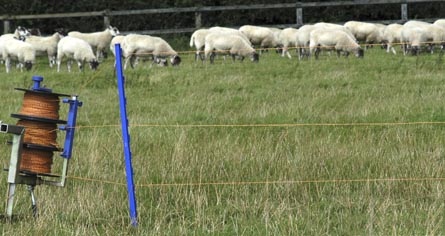
Sheep

Sheep can be relatively difficult to contain with an electric fence because, although they tend to be docile, in winter they do have thick fleece, presenting unique challenges because wool does not conduct electricity and so requires more power than shorthaired animals. Exclusion of predators such as foxes can frequently be a problem in Spring when lambs are born.
Sheep require 3,000 - 4,000 volts on the fence
line together with an energiser with not less than 1.5 joules of stored energy
and higher on long fences. Voltage levels are affected by vegetation on the
fence line, length of fence and type of wire. Ideally a minimum of 4,000 - 5,000
volts on the fence line is required to keep out predators such as foxes from
young lambs.
Note: because lambs are erratic
and a target for predators, consider the use of electric netting, particularly
for lambing pens, as it makes containing lambs and exclusion of foxes much
easier.
Goats

To safely contain goats, you need an energiser that maintains 4,000 - 5,000 volts on the fence line and around 1.5 jJoules of stored energy depending on the fence length.
Goats require closely spaced fence wires that start low to the ground and are
high enough to prevent jumping over the fence. We recommend using five to six
wires spaced to an overall height of 100 – 115cms (40 – 46 inches).
Alternatively consider the use of Rutland electrified netting which is
simple to erect and use on small installations.
Wire Spacing Guide for Sheep and Goats
Depending on a variety of factors, particularly the breed of sheep and whether
or not they are used to electric fencing, the number of fence wires can vary
from three to six, depending on:
- Is the fence temporary for holding on
fodder beet or similar?
- Will you keep lambs and ewes together?
- Are
predators a problem?


 川公网安备51082402000210号
川公网安备51082402000210号